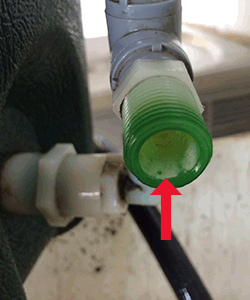
Applicator troubleshooting mystery: An elusive solution
 By Jon Urness, Vita Plus national forage specialist
By Jon Urness, Vita Plus national forage specialist
“Help! My applicator isn’t putting out what it should!”
Most everyone who works with forage applicators has heard that plea. The solution is usually a simple matter of replacing the flexible pump tube on the Dohrmann DE applicators. However, things were different this time when I received a call from a custom harvester.
The harvester said he already replaced the tube and still could only manage about 3 tons per minute on the red flow meter scale. That’s about 60 percent of the normal capacity of 5.5 tons per minute on a DE-1000. In this case, it wasn’t a huge concern because he was chopping first- and second-crop haylage and normally does not chop at a rate more than 3 tons per minute.
However, when it comes time to do corn silage, he’ll need the applicator to put out maximum volume. A stop at the harvester’s shop revealed a number of clues that led us to an unusual cause of the problem.
 I started by completely cleaning the unit and making sure the new tube was the correct type and was installed correctly. One of the first things I noticed was a bad case of clogged arteries. A large buildup of creamy white material covered the inside of all tube and valve surfaces.
I started by completely cleaning the unit and making sure the new tube was the correct type and was installed correctly. One of the first things I noticed was a bad case of clogged arteries. A large buildup of creamy white material covered the inside of all tube and valve surfaces.
The harvester said he was using a water-soluble inoculant that called for an application rate of 4 to 16 grams per ton. He doubled the minimum rate and was applying at 8 grams per ton. (For reference, Vita Plus Crop-N-Rich MTD/1 is applied at 1 gram per ton and Crop-N-Rich Stage 2 is applied at 2 grams per ton.)
After cleaning everything (including a good soak of the flowmeter, which can be a source of stickiness for the black indicator ball) and putting it back together, the unit still only put out 3 tons per minute on the red scale (3.84 ounces per minute on the black scale) – and this was using clear water.
The pump motor seemed to be laboring a bit. I had often heard from both Dan and Amber Dohrmann of Dohrmann Enterprises, Inc. (manufacturers of the Dohrmann DE applicators) that pump tube pressure can be altered by adjusting the yolk that squeezes down the pump tube. However, it’s generally best to leave that alone. I tried simulating greater pressure on the tube by pressing down on the yolk with my fingers, but this slowed the pump and reduced maximum flow even further.
 Next, I slipped a fingernail under the yolk to relieve pressure….voila! Maximum flow came immediately. All I had to do was back out the pump yolk adjustment screw a couple of turns and we were good to go.
Next, I slipped a fingernail under the yolk to relieve pressure….voila! Maximum flow came immediately. All I had to do was back out the pump yolk adjustment screw a couple of turns and we were good to go.
The Dohrmanns’ advice to avoid this adjustment is generally good, but, on this machine, it was the solution to the problem. Intuitively, when output is not up to par, an operator may feel that greater pressure on the pump tube is needed, but, in this case, I clearly discovered that less pressure was the fix.
| Category: |
Equipment Forage Foundations Forage inoculants |

